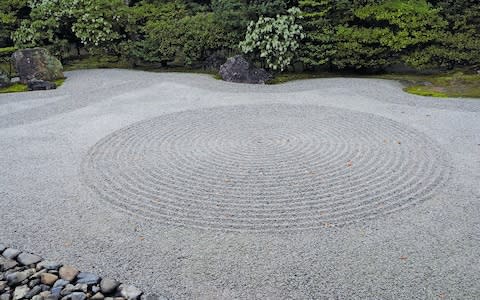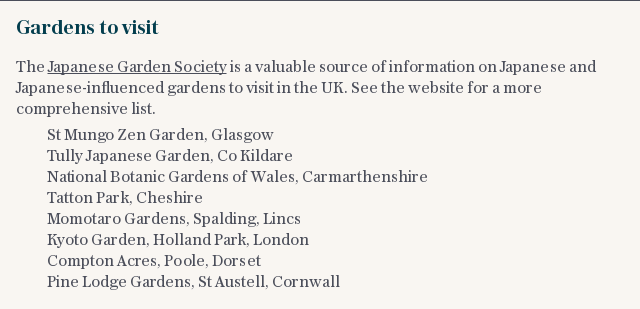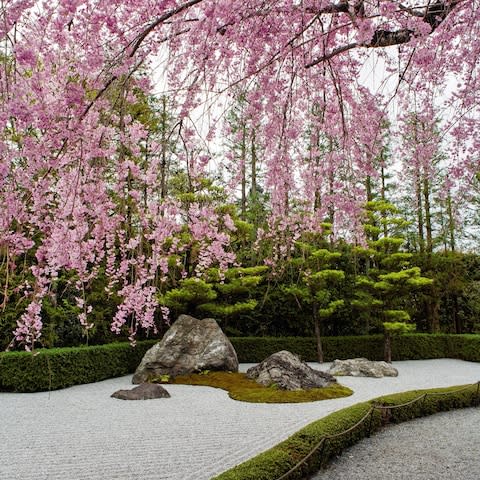Japanese gardens: the enigmatic art of raked gravel and rocks does not give up its secrets lightly
New York’s Strand bookshop comprises 18 miles of new and used books, four cases of which – on two separate floors – are dedicated to gardening and garden design. When I was there last week, the quantity of books devoted to Japanese gardens was noticeable. They ranged from recent publications to a modish edition of David H Engel’s 1959 Japanese Gardens for Today. Here, in the West’s most frantic city, was a tiny encapsulation of our longstanding pursuit of the world’s most calming – and challenging – landscape design.

Sophie Walker is the latest designer attempting to unravel the mysteries of Japan’s esoteric gardens, although she has been fascinated by their form – specifically, the Zen gardens – since visiting the country during her first years as a garden designer, and being presented with the challenge of Kyoto’s famously minimalist Garden of the Leaping Tiger.
“In Japan I discovered gardens where I didn’t know what to look at. Zen gardens [consisting of rocks, water and pruned trees] don’t offer an image,” she explains. “I realised I’d have to keep visiting and give them more time.” Walker did, immersing herself in Japanese culture in an attempt to better understand the philosophy behind the nation’s gardens, eventually publishing her findings in a book, The Japanese Garden (Phaidon).
I understand Walker’s intrigue: I’ve been to Japan three times in the past three years, finding myself drawn deeper into the country’s landscape and away from civilisation with each return visit. But while I’ve always sought out and admired the gardens on my travels, I’ve often been left cold. They are undeniably beautiful and pacifying, but somehow untouchable. A hunt for a hidden gem of a garden – often just a few metres square, and unfettered by crowds of tourists – may bring you to one laid out in front of a bamboo viewing platform, such as that created by the poet Ishikawa Jozan in the temple of Shisen-do in Kyoto, or a space filled only by raked gravel. These are gardens to be looked at from a distance, not held or inhaled as you wander through foliage.
The Japanese Garden offers an explanation of the semantic foundations of Japanese garden design through essays – from, among others, the influential architect Tadao Ando, Malaysian writer Tan Twan Eng, author of Booker Prize-shortlisted novel, The Garden of Evening Mists, and artist Lee Ufan. It also includes a comprehensive collection of photographs. Tourist favourite Fushimi Inari Taisha, known for its thousands of orange torii gates, is in there, but so is the Teshima Yokoo House, located on one of cluster of tiny fishing islands that have, in recent decades, become home to modern art.

The book could act as a very good alternative guide to an ambitious horticultural trip. Rather, however, Walker’s point is that we should embrace the ethos of Japanese gardening – that it exists to transport our minds and build our inner worlds, rather than be used to expand our experience of what is around us – and channel that appreciation of nature into garden design. She speaks of the Void Garden, or The Garden of the Mind, in Kyoto, which consists only of raked gravel and a washbasin. “It’s the most conceptually challenging garden you can think of,” she says. It is accompanied by the slightly more decorative Garden of the Body and Garden of the Soul. These have been around for centuries: the hojo garden at Kennin-ji, which interrupts its gravel circles with an artfully grown tree, was formed in 1202.
As with that other great Japanese art, sushi, Zen gardeners must serve a long apprenticeship: they can spend eight years observing their elders before even touching a tool. Only after they’ve learned to clean tools are they able to garden. As a Western gaijin, or foreigner, Walker’s study of Japanese gardening was rarely smooth: “There were a number of situations where they didn’t want to share their knowledge with me,” she explains. “How could I tame knowledge that others have been observing for many years? Some Japanese people are very protective of what they see as being lost if they share it with someone who doesn’t have the groundwork to understand what it means.”

While Japanese gardens can be imitated with maple and cherry trees or copious planting of bamboo, the strategic placing of torii or stone shrine in a pond – witnessed in Japanese gardens from Brooklyn to Holland Park – rather misses the point, she says. “It’s a misconceived idea that Japanese gardens are a stylised form.” Instead, she encapsulates why Japanese gardens can seem so beguiling to a Western viewer: “It’s there for your mental stimulation, not for your experience.” Those wanting to evoke Japanese planting at home, however, may find the section dedicated to Japanese plants at the back of Walker’s book highly useful.
The original Zen gardeners were stonecutters or priests, people whose care of the garden went hand-in-hand with daily meditation. “If you involve yourself in the day-to-day running of the garden, you become wholeheartedly engaged with that action,” Walker says. “In that moment, an awakening might occur.”
In this respect, Japanese gardening isn’t so alien, as anyone who has found connection and peace in their garden will know. As Walker says: “Many a great thought has occurred while weeding the garden.” In Japan, the gardens are designed to encourage those who admire them to think, too.
The Japanese Garden by Sophie Walker (Phaidon, £49.95) is published Oct 30. To order your copy for £40 with free p&p call 0844 871 1514 or visit books.telegraph.co.uk


